Opened: March 3, 1924 with a Ziegfeld production of "Sally" starring Leon Errol. The musical was written by Jerome Kern, Clifford Grey and Guy
Bolton. It originally opened on Broadway in 1920, had a 1923 revival at
the New Amsterdam Theatre, and was on the road for years. Wikipedia has an article about it.
The theatre was a project of real estate man Joe Toplitzky and under the management of the Erlanger circuit, a firm run by Abraham Lincoln Erlanger that also had the Mason Theatre on Broadway. Will Rogers was the opening night emcee and tickets were $10.00. The opening night photo from the Herald Examiner archives appears in the Los Angeles Public Library collection.
A section of the Biltmore. Grand Ave. is on the right.
The main floor plan. 5th St. is on the bottom, Grand on the right.
"Inaugural Performance - This entire ticket may be retained as a souvenir of the opening performance." Thanks to Brenden Rittenberry for the photo of the brass ticket in his collection. He notes it's resting on its original protective cloth sleeve. The ticket noted that A.L. Erlanger and Joe Toplitzky were the owners with Edward D. Smith as manager.
Seating: 1,652 with 709 on the main floor, 60 in the boxes, 72 in the 1st balcony loge, 430 in the upper section of the 1st balcony and 385 in the 2nd balcony.
Stage Specifications:
Stage depth: 29' 6" according to a 1964 L.A. Times article
Curtain to footlights: 2'
Stage wall to wall: 77'
Grid height: 70'
Rigging: hemp, 36 sets, pinrail at stage level off right
Dressing rooms: 11 above stage level, 4 in the basement
Power: both AC and DC
The stage data and seating breakdown comes from the 1949 edition of the "ATPAM Theatre, Arena and Auditorium Guide." It's on Bob Foreman's terrific Vintage Theatre Catalogs site.
For four decades the Biltmore was the premier venue for touring Broadway shows playing Los Angeles. The Biltmore was still part of the Erlanger circuit during the 30s and 40s and busy all the time. The decline began, as it did for many movie theatres, with the advent of television. Performers of note included George Arliss (in "Merchant of Venice"), Ethyl Barrymore (in "Constant Wife" and "Laughing Lady"), John Barrymore, Lionel Barrymore, John Carradine, Katherine Cornell, Noel Coward, and Jeanne Eagels (in "Her Cardboard Lover").
Other greats appearing on the Biltmore stage included Maurice Evans, Al Jolson (in "Mammy"), Gertrude Lawrence, Pauline Lord (in "Strange Interlude" and "The Glass Menagerie"), Bela Lugosi (in "Dracula," 1928), Alfred Lunt and Lynn Fontanne, Fredric March (in "The Royal Family"), the Marx Brothers (in "Cocoanuts"), Otis Skinner, Mae West (in "Diamond Lil"), Bert Wheeler and many more.
The theatre is seen in the upper left corner of a plan on the back of this brochure for the Biltmore, "A city of service under one roof." Thanks to Noirish Los Angeles contributor Ethereal Reality for finding it for his Noirish post #3778.
"The Fanny Brice Revue" opened in March 1927. The show, a production of Louis O. Macloon, had originally opened February 2 at the Music Box Theatre in Hollywood as the "Music Box Revue." Thanks to J.R. Graham for locating the March 15 L.A. Times ad for her article "6126 Hollywood Boulevard: Music Box Theatre."
A cover of the June 1927 program for "The Shanghai Gesture" directed by Guthrie McClintic. See the full program on Danni Bayles-Yeager's site. Also see her page on the Biltmore.
The Paramount film "Wings" got a 5 month run beginning January 15, 1928. The film ran twice daily with all seats reserved. Thanks to Cinema Treasures contributor Dallas Movie Theaters for finding this nice ad. The immensely profitable run lasted longer than the time anticipated. Erlanger had to shuffle bookings around as various legit shows had been scheduled to play the theatre.
The program for "Dracula" in 1928. It's from the collection of Lane Wallace. Yes, Bela Lugosi was on the road playing the part. Also see the reverse side.
A September 20, 1928 Times ad for the Cecil B. DeMille film "The Godless Girl" from Pathe. There was also an article that day. It was in its 5th week but Cecil himself and many of the stars of the film were going to show up at the theatre that night as it had been designated Culver City Day. The film had opened August 21.
Another fall film in 1928 was the indie "Simba." It opened October 9. The ad is from the October 10 L.A. Times where it also got a review.
The program cover for the 1937 production of "Brother Rat," a comedy starring Tom Ewell and Paul Ballentyne. The image appeared on the now-defunct website TheatrePrint.
Helen Hayes played "Victoria Regina" in a 1938 road production at the Biltmore. Thanks to Lane Wallace for sharing the program from his collection. Also see the reverse side.
A program for the 1940 engagement of George White's "Scandals" that included Ann Miller in the cast. It's from the collection of Danni Bayles-Yeager. Also see the reverse side. Thanks, Danni!
A 1944 ad for a run of "Blossom Time" that appeared in an issue of Playgoer magazine. Thanks to Eric Lynxwiler for sharing it on Flickr. It's in his wonderful Paper Ephemera collection.
Martin Platt comments: "Saw
all those Civic Light Opera shows there that the Baptists wouldn't let
into Philharmonic Auditorium - like 'Gypsy' and 'Irma la Douce.'"
A May 1958 story about a sale of the building. The owner was the estate of Marcus Helman of New York, one of the original builders. The purchasers were restaurant owner Paul Cummins and his wife Ruth who raised the possibility of demolition if enough theatrical bookings weren't forthcoming. The demolition worries were premature, but only by a few years. Thanks to Ken McIntyre for adding this as a comment to a post on the Photos of Los Angeles Facebook page.
Closing: April 25, 1964 was the last night of operation. "Enter Laughing" with Yvonne DeCarlo, Alan Mobray and Alan Arkin finished a 23 week run. As Doolittle noted in the Times article the theatre was the last of the downtown legit theatres but was no longer needed with the opening of the Music Center. He added: "We salvaged the Biltmore and gave it five years of extra life when they were going to tear it down for a garage. It was the only theater left in Los Angeles. We staged 60 or 70 productions there, enjoyed by two or three million people."
Status: The theatre was demolished in 1964 at an estimated cost of $100,000. The L.A. Times ran a story about the beginning of the demolition in their September 3, 1964 issue.
The owners at the end were Joseph Harris, David Karno and Joseph Rubin of Biltmore Associates. They didn't have a specific plan other than turning the site into a parking lot pending future development. They noted that there hadn't been any steady demand for use of the building and the taxes were killing them. After years as a
parking lot, a tower addition to the hotel was built on the site in the
1980s.
Lobby areas:
Looking across to the house right end of the main lobby and the entrance doors onto 5th St. The 1924 photo is in the Los Angeles Public Library collection. The standee area at the rear of the main floor and the stairs to the balconies are through doors on the left.
Closer to the 5th St. doors. It's one of 10 Mott Studios photos taken in 1924 that are in the California State Library photo set #001384377.
Coming in for a Christmas Eve show in 1942. It's a Los Angeles Public Library photo from their Herald Examiner collection.
Looking across to the house left end of the lobby. The door on the left was to the coat check room. The exit doors went out to a passageway on the south side of the theatre. Photo: Mott Studios - California State Library - 1924
One of the theatre's lounge areas, perhaps the men's smoking room. Photo: Mott Studios - California State Library - 1924
A construction view of the house left box area. It's a photo in the Los Angeles Public Library collection.
More exterior views:
1924 - The afternoon of the theatre's March 3 opening. It's a Los Angeles Public Library photo.
1924 - Looking west on 5th with the theatre running the the John Golden touring production of Frank Bacon and Winchell Smith's play "Lightnin." It was the second show to play the Biltmore, opening on March 17. It's Los Angeles Public Library photo.
1924 - The entrance from across the street. The musical comedy "Caliph" with Raymond Hitchcock was playing the theatre in July. Photo: Mott Studios - California State Library set #001384377
1924 - Looking toward the hotel. Photo: Mott Studios - California State Library
1924 - The view west on 5th toward Grand Ave. Photo: Mott Studios - California State Library
1924 - The view east across Grand. Those are the dressing rooms on the corner. The stage loading door was in the arch at the far right. Photo: Mott Studios - California State Library
1924 - A detail of a retail space on the 5th St. side of the stage end of the building. Photo: Mott Studios - California State Library
c.1925 - A photo from the Los Angeles Public Library collection.
c.1925 - The Library's groundbreaking ceremony. It's a photo from the California Historical Society collection appearing on the USC Digital Library website.
c.1925 - The site of the new Central Library at the right. It would open in 1926. The block was formerly the site of the State Normal School. It's a Los Angeles Public Library photo.
c.1926 - Looking south on Grand toward 5th with the Biltmore Theatre on the left and the Criterion way in the distance at 642 S. Grand. It's a photo in the Security Pacific National Bank Collection at the Los Angeles Public Library. The Mayflower Hotel, now the Hilton Checkers, would soon rise on the right, just beyond the Library's lawn.
1926 - A detail from the image above furnished by Christina Rice, head of the
LAPL Photo Collection. The film had opened August 2 and ran until
mid-November.
1930 - The Biltmore Theatre is in the center of this detail from the USC Dick Whittington panorama. The rounded roof of the Philharmonic Auditorium can be seen in the upper center. That's a bit of the Library's tower in the lower left and the Edison Building/One Bunker Hill under construction across 5th. See Scott Collette's fine post of images from this panorama on his
Facebook page Forgotten Los Angeles. It's also on Instagram.
1937 - A Herman Schultheis photo in the Los Angeles Public Library collection. "Room Service" opened at the Biltmore on October 4.
c.1943 - A shot from an album of 1943/44 views located on ebay by Noirish Los Angeles contributor Ethereal Reality. He featured this one in Noirish post #62655. Nope, can't quite read the Biltmore's marquee. On the left it's a Rent-A-Car office in the Biltmore Garage building and, down at Olive St., the San Carlos Hotel. The Philharmonic Auditorium is down on the other side of Olive.
1948 - A look across to the theatre from Upper 5th St. Workers are changing the Biltmore's marquee. Upper 5th no longer exists but had once curved around the front of the Edison Building and connected to the south end of the segment of Hope St. that ran up Bunker Hill. Thanks to Martin Turnbull for locating the photo for a post on his Hollywood's Garden of Allah Novels Facebook page.
1949 - Up on the balcony level breezeway with a policeman inspecting one of the giant vases after someone had tried to push one into the street. It's a Herald Examiner photo in the Los Angeles Public Library collection.
The perp called himself "Superman." Playing at the time was a production of Shaw's "Man and Superman." Other photos from the break-in from the Library's collection include views of the perp in handcuffs, radiators pulled from walls, and seats kicked over.
1949 - Five theatregoers pose for a snapshot. It's a Los Angeles Public Library photo.
1962 - Looking east on 5th with the Biltmore Theatre on the right. Note the vertical sign for the Auditorium Bldg. in the next block on the left. It's a William Reagh photo in the California State Library collection as their item # 001383078
1963 - A display case detail. The William Reagh photo is in the Los Angeles Public Library collection.
1964 - "Show With a Bang." Cleveland Wrecking Co. on the job. It's a Los Angeles Public Library photo.
1964 - A demolition view by William Reagh. It's from the California State Library collection, their item # 001382805.
1973 - Looking west toward the Library and the Arco Towers. That's a corner of the Biltmore on the left. The parking lot beyond had been the site of the theatre. It's a Victor R. Plukas photo in the Los Angeles Public Library collection. The Library also has a similar 1971 photo by Mr. Plukas.
The Biltmore in the Movies:
Stan Laurel and Oliver Hardy are cycling south on Grand toward 5th St. in the two-reel short "Duck Soup" (Hal Roach/Pathé, 1927). The stagehouse of the Biltmore is on the left just after the intersection. Over on the right are the grounds of the Central Library.
Woodrow Wilson, played by Alexander Knox, is onstage at the Biltmore for a political rally during his campaign for New Jersey Governor in Henry King's film "Wilson" (20th Century Fox, 1944). The film stars Geraldine Fitzgerald, Thomas Mitchell, Ruth Nelson, Mary Anderson, Ruth Ford, Madeleine Forbes, Charles Coburn, Vincent Price, Eddie Foy Jr. and Cedric Hardwicke. The cinematography was by Leon Shamroy and an uncredited Ernest Palmer.
Thanks to Kurt Wahlner for identifying the Biltmore in the film and getting many screenshots. See the Historic L.A. Theatres in Movies post for seventeen more Biltmore shots as well as eleven showing the film's venue for the 1912 and 1916 Democratic conventions, the Shrine Auditorium's Expo Hall.
When Dennis O'Keefe and Gale Storm take a walk up Grand Ave. about twenty-eight minutes into "Abandoned" (Universal-International, 1949) we get a look toward the stage end of the Biltmore over on the left. He's a newspaper reporter and she's trying to uncover what happened to her murdered sister. Along the way they investigate a baby broker racket and more.
Thanks to David Kimbrough for noting the "Target Earth" use of Bunker Hill locations in a Facebook post for the Images and Memories of Los Angeles group that included many screenshots. He notes that a poorly colorized version of the film is on Internet Archive. Not a good movie by any stretch of the imagination but we do get some nice shots including views of the Library, the Mayflower Hotel (now the Hilton Checkers) and the Grand Ave. side of the Edison Building. David notes that some of the less obvious locations include Bob's Cafe at 708 W. 3rd, Stanley's Barber Shop at 704 W. 6th, Boulevard Stationers at 5406 Wilshire and the intersection of Virgil and Beverly.
More Information: Floyd B. Bariscale has a fine Biltmore Hotel article as part of his Big Orange Landmarks series. Cinema Treasures has a page about the Biltmore.
The Pacific Coast Architecture Database has pages on the Biltmore Hotel and the Biltmore Theatre. See the Wikipedia article on the Biltmore Hotel.
See Nicholas Beyelia's "The Host of the Coast: 100 Years of the Los Angeles Biltmore," a 2023 article on the Los Angeles Public Library website.
| back to top | Downtown: theatre district overview | Hill St. and farther west | Broadway theatres | Spring St. theatres | Main St. and farther east | downtown theatres by address | downtown theatres alphabetical list |
| Westside | Hollywood | Westwood and Brentwood | Along the Coast | [more] Los Angeles movie palaces | the main alphabetical list | theatre history resources | film and theatre tech resources | theatres in movies | LA Theatres on facebook | contact info | welcome and site navigation guide |








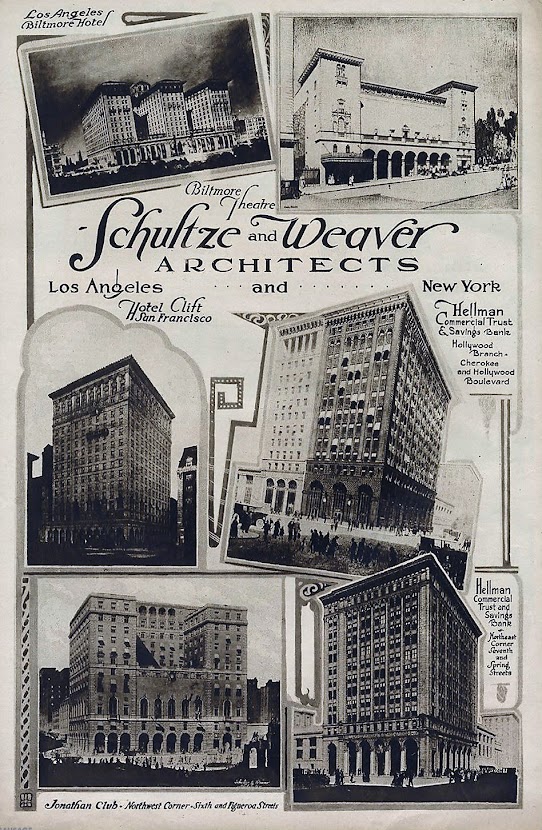



































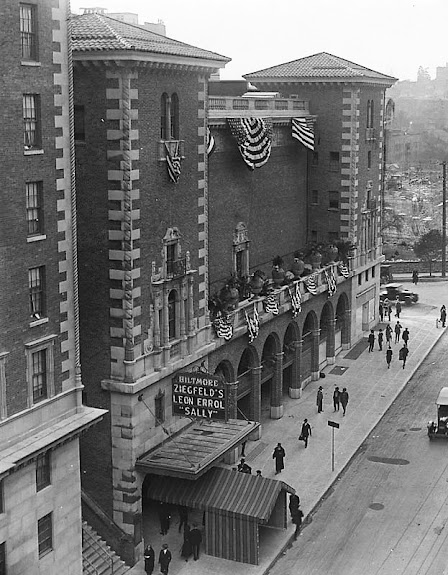


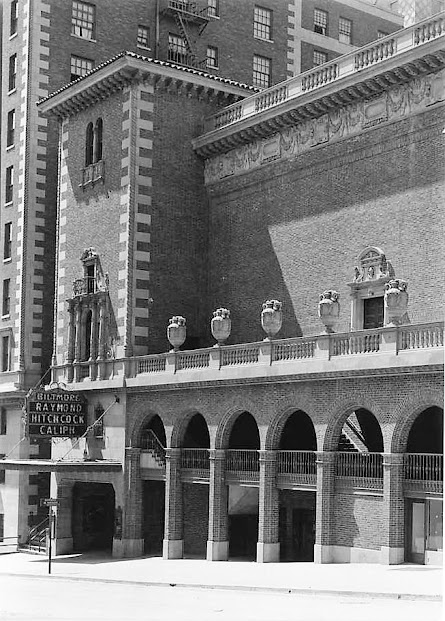









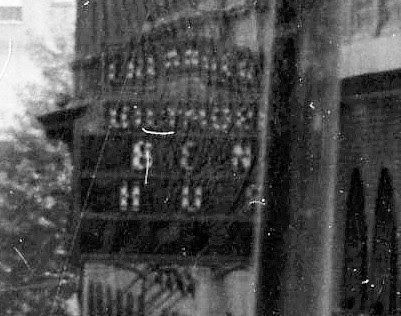


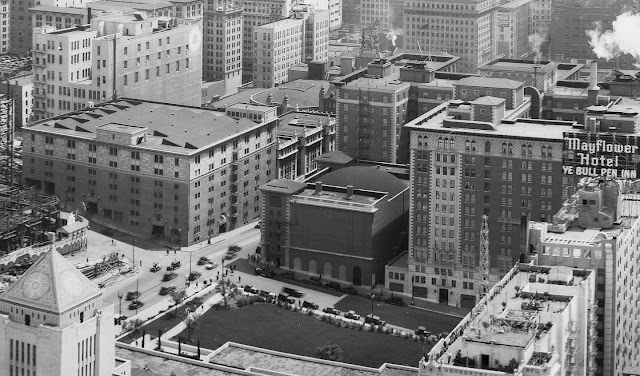



















Shultz & Weaver was a new firm when both Biltmore projects were built, Shultz having previously worked at Warren & Wetmore. He was the head of design and construction for Grand Central and related structures which included the NY Biltmore.
ReplyDeleteWhen I was nine years old I saw my aunt Katherine Hilgenberg in The Sound Of Music at The Biltmore in February 1964 - I remember being backstage before and after the production. Incredible memory and obviously one of the last shows presented there.
ReplyDeleteThanks for sharing your memories. Now, I just want to see all those backstage photos you took!
Delete